|
 Shamanism:
Shamanism:
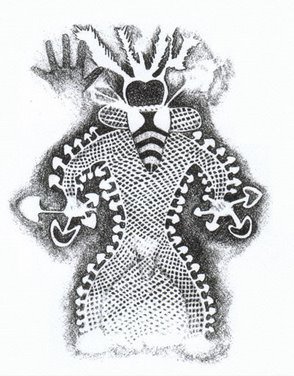
The
social function of the Shaman was oracle, healer and spiritual guide
all in one. Their job it was to maintain a
connection with the spirit world.
The modern concept of a shaman is based on early
stereotypes and Victorian values. Shaman were able to communicate through the
Earth-spirit. They were often associated to an animal, or familiar.
Quick
Links:
The
word shaman originated among the Siberian Tungus (Evenks) and literally
means he (or she) who knows. The concept of a shaman was almost lost in
the 20th century, but it is making a slow revival in 'new-age' cultures.
In essence, shamanism is a belief system, similar to many religions
today, it is often spoke of as one of the first 'religions' practiced by
people.
There is a
growing belief that a high percentage of rock art is of a shamanic
origin.

10-15,000 year
engraving is said to be a
depiction of a shaman. (From Les Troise Freres cave, France).
In his book 'Supernatural', Graham
Hancock makes the case that shamanic experiences led to the sudden
development of art, symbolic thinking, and early civilization (pp.
29-31).
Whether we find its traces in
Australia, Asia Africa, or Europe, it is simply impossible to
overstate the uniqueness and peculiarity of the evolutionary event
by which we were drawn into fully modern consciousness and the fully
modern capacity for symbolism and culture, religion, and art. No
ancestor in the human lineage had ever made use of any form of
symbolism before, and needless to say, no other animal species had
ever done so either. But the switching-on of humanity's
symbol-making capacity between approximately 100,000 and 40,000
years ago was the change that changed everything.
The idea that most cave-art
originated from the shamanic experience is not one to be lightly
ignored. The connection of the shaman to the mother-earth through
imaginative and magical symbols is a serious proposition and should be
considered with the greatest care. Although interpreting cave art is
undoubtedly a matter of opinion, there are several recognised pieces
which appear to show shamanic images.
(More about
Prehistoric Cave-art)
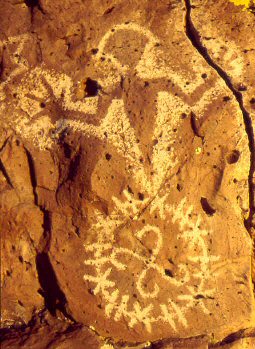
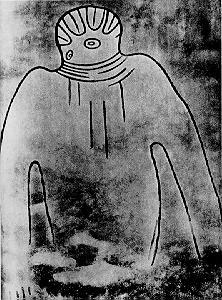

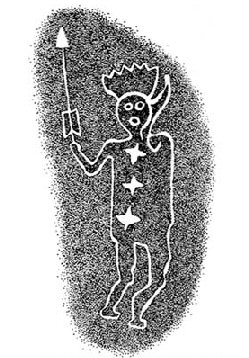
Generally, the shaman enters the
spirit world by effecting a transition of consciousness, entering into
an dream state, ecstatic trance, either auto-hypnotically or through the
use of intoxicants. The methods employed were diverse, and are often
used together. Some of the methods for effecting such trances are as
follows: Fasting, drumming, dancing, and psychedelic drugs.
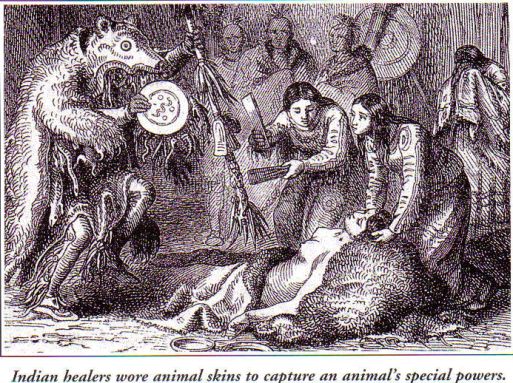
|
One of the defining
characteristics of a shaman is their ability to see beyond
three-dimensions.
|
The oldest
Shaman in the world
 Article: National Geographic (Nov 2008): Article: National Geographic (Nov 2008):
Archaeologists
in northern Israel say they have discovered the world's oldest known
grave of a shaman. The 12,000-year-old grave holds an elderly female of
the mysterious Natufian culture, animal parts, and a human foot.
Hundreds of Natufian graves have been excavated in Israel, Jordan,
Syria, and Lebanon. But only the one uncovered by Grosman contains a
woman believed to have been a shaman.
The 1.5-meter-tall (nearly 5-foot-tall),
45-year-old woman was relatively old for her time. After her death,
she was placed in a mud-plastered and rock-lined pit in a cave and was
buried beneath a large stone slab.
She was not
buried with everyday items and tools, as hunters, warriors, or
political leaders were. Instead, her grave contained 50 arranged
turtle shells and parts of wild pigs, eagles, cows, leopards, martens,
and a human foot,
(Click here for full article)
Eliade
(3), argues that vestiges of shamanic activity
'remain among all the European peoples'. He believed that
its persistence and spread across Europe and Asia resulted from a
'systematic reorganisation of magico-religious life' that was basically
accomplished at a period when the proto-Indo-Europeans had not yet
separated'. He continues by saying that
traces of Shamanism can be found in
ancient Greece where the 'few figures of Greek legend who can be
compared to Shamanism are related to Apollo'. These legendary
figures are said to have come 'from the north', from the land of the
Hypoboreans. (1)
In 1988, David Lewis-Williams of the University of
Witwatersrand in Johannesburg, South Africa, launched one of archaeology's
longest-running controversies when he proposed that the vivid cave paintings of
Upper Palaeolithic Europe were produced by shamans whose consciousness had been
altered by drugs or self-induced trances.
Article:
http://www.archaeology.org/0511/reviews/neolithic.html

Psychedelic mushrooms were called 'Holy Children'
by the Mazatec shamen.

Terrence Mckenna - It is well known fact that psychotropic drugs
induce altered states of consciousness. It was argued by Terrence
McKenna that they were a leading stimulant in the evolution of the
human brain, and the origin of language and religion. This theory
did not originate with Mckenna. In 1986, shortly before his passing,
Gordon Wasson put forth his own theory on the origin of religion
from hallucinogenic mushrooms, specifically Amanita muscaria,
with examples from several cultures that he had previously
described, in details. In addition, Wasson also believed that Soma
was responsible for:
"A prodigious expansion in Man's memory must have been the gift that
differentiated mankind from his predecessors, and I surmise that
this expansion in memory led to a simultaneous growth in the gift of
language, these two powers generating in man that self-consciousness
which is the third of the triune traits that alone make man unique.
Those three gifts - memory, language and self-consciousness - so
interlock that they seem inseparable, the aspects of a quality that
permitted us to achieve all the wonders we now know."
(2)
A modified version of this theory was later
developed by McKenna, in the late 1980's. His theory differed from
Wasson in that Mckenna believed that mushrooms containing the
entheogen psilocybin, and he specifically says Stropharia
cubensis, was responsible for the origin of religion and
development of memory, language and self-consciousness. According to
Mckenna, both events occurred in Africa, and began during the
prehistoric, nomadic, hunting/gathering period of man's existence.
The conclusion that Stropharia cubensis was "The Tree of
Knowledge" was based on the elimination of plants containing
entheogens that are available in Africa. Mckenna
further restricted the plants considered to those having entheogens
with indole compounds, which are characteristically strong visionary
entheogens. With these prerequisites, the list of hallucinogenic
plants was short:Tabernanthe iboga and Peganum harmala
(Syrian Rue). Although both are known to be used by religious cults,
these species were eliminated from consideration. The roots of
Tabernanthe iboga contain the the alkaloid ibogaine, the
entheogen, is required in far greater amounts than would normally be
consumed in a meal by early man. In addition, its usage is only
traced as far back as the 19th. While Peganum harmala may be
found through the arid part of Mediterranean North Africa, there is
no history of its usage here and it, again, must be too highly
concentrated or must at least be combined with dimethyltryptamine (DMT)
before it will produce an hallucinogenic effect. With the
elimination of these two species, McKenna was left only with
psilocybin mushrooms. These mushrooms could be found abundantly
growing on the dung of the hooved animals that grazed in the
grassland areas where they were being hunted. Stropharia cubensis
was singled out because it was the only species thought to produce
psilocybin in concentrated amounts and to be free of other compounds
that may produce side-affects. It was the addition of the
Stropharia to the diet of early man that led to better eyesight
(an advantage for hunters), sex, language, and ritual activity
(religion among them), when eaten. McKenna suggested that the
mushroom augmented the above traits by changing the behaviour of
individuals. These changes in behaviors favored increased usage
of language, leading to an increase in vocabulary to communicate
when hunting and gathering. Although evolution was occurring on the
genetic level, due to increase in mutations from the change in diet
that had occurred, according to McKenna, social evolution,
due to the mushroom consumption was responsible for the above
changes.
At the same time that language was
developing, religion also began. When taken at levels that cause
intoxication, a feeling of ecstasy occurs, with hallucination and
access to what the user would perceive as the realm of the
supernatural. This led to the origin of the shaman whose duty is
to communicate with the unseen mind of nature.
 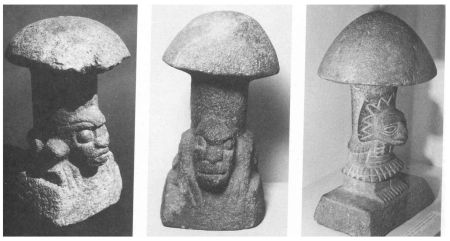 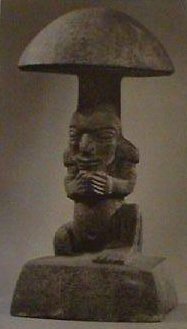
Samples from the cache of ten
mushroom figurines discovered in Guatemala city and dated at
around 100 - 300 BC
|
Article: The Lycaeum.
(1992)
The idea that the use of hallucinogens should be a source of
inspiration for some forms of prehistoric rock art is not a new
one. After a brief examination of instances of such art, this
article intends to focus its attention on a group of rock
paintings in the Sahara Desert, the works of pre-neolithic Early
Gatherers, in which mushrooms effigies are represented
repeatedly. The polychromic scenes of harvest, adoration and the
offering of mushrooms, and large masked "gods" covered with
mushrooms, not to mention other significant details, lead us to
suppose we are dealing with an ancient hallucinogenic mushroom
cult. What is remarkable about these ethnomycological works,
produced 7,000 - 9,000 years ago, is that they could indeed
reflect the most ancient human culture as yet documented in
which the ritual use of hallucinogenic mushrooms is explicitly
represented. As the Fathers of modern ethno-mycology (and in
particular R. Gordon Wasson) imagined, this Saharian testimony
shows that the use of hallucinogens goes back to the Paleolithic
Period and that their use always takes place within contexts and
rituals of a mysfico-religious nature.
(Click here for full article)
(More about the use
of Drugs in Prehistory)
|
The She-Shaman.
One of the burials
at Dolni Vestonice, Czech revealed a human
female skeleton, ritualistically placed
beneath a pair of mammoth scapulae, one
leaning against the other. The bones and
the earth surrounding it contained
traces of red
ochre, a
flint spearhead had been placed near
the skull and one hand held the body of
a
fox. This evidence has led to suggestions that
this was the burial site of a
shaman. This is the oldest site not
only of ceramic figurines and artistic
portraiture, but also of evidence of
female shaman.
(More
about Dolni Vestonice)
|
Article:
(14 Jan,. 2013). Eurekalert.org
'4,000-year-old shaman's stones discovered near Boquete, Panama'
'Archaeologists working at the Smithsonian
Tropical Research Institute in Panama have discovered a cluster
of 12 unusual stones in the back of a small, prehistoric
rock-shelter near the town of Boquete. The cache represents the
earliest material evidence of shamanistic practice in lower
Central America. Based on the placement and the unusual
composition of the stones in the cache, Richard Cooke, STRI
staff scientist, suggested they were used by a shaman or healer.
Consulting geologist Stewart Redwood determined that the cache
consists of a small dacite stone fashioned into a cylindrical
tool; a small flake of white, translucent quartz; a bladed
quartz and jarosite aggregate; a quartz crystal aggregate;
several pyrite nodules that showed evidence of use; a small,
worn and abraded piece of chalcedony; a magnetic andesite flake;
a large chalcedony vein stone; and a small magnetic kaolinite
stone naturally eroded into an unusual shape, similar to a
flower'.
(Link
to Full Article)
|
|
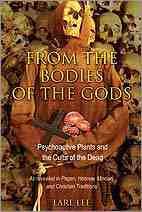







 Article: National Geographic (Nov 2008):
Article: National Geographic (Nov 2008):




